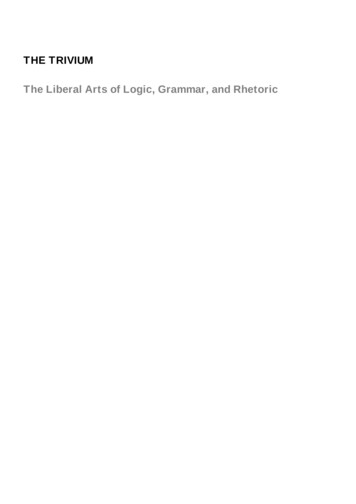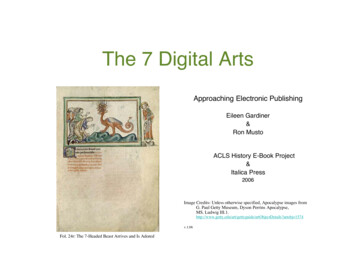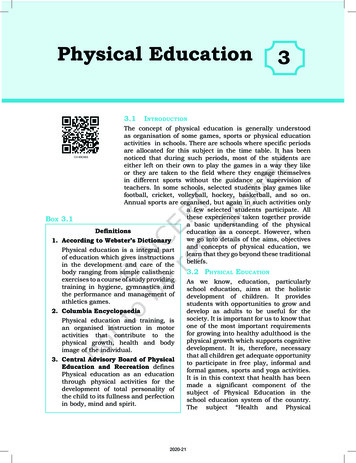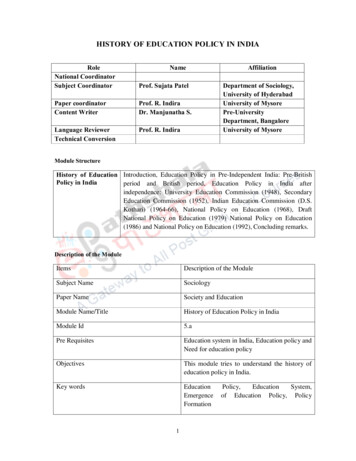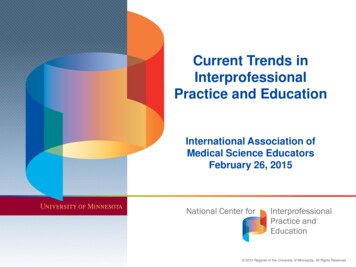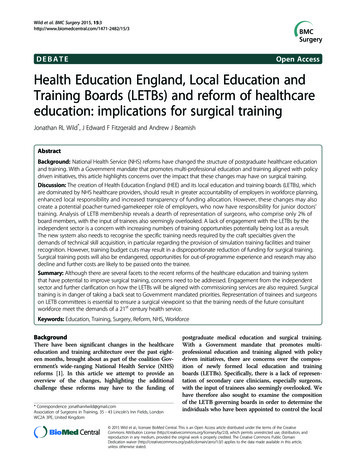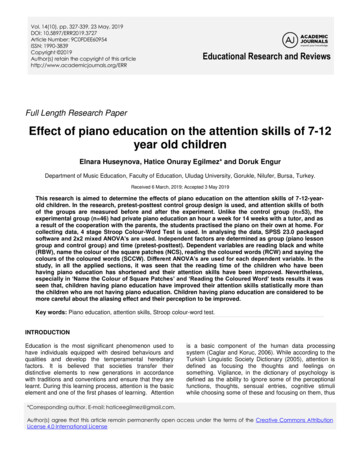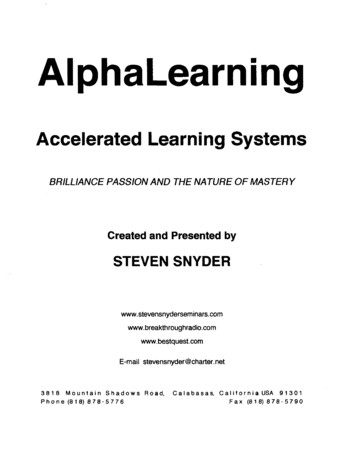
Transcription
AlphaLearningAccelerated Learning SystemsBRILLIANCE PASSION AND THE NATURE OF MASTERYCreated and Presented bySTEVEN SNYDERwww. ww.bestquest.comE-mail stevensnyder@charter.net3 8 1 8 M o u n t a i n S h a d o w s Road,P h o n e (818) 8 7 8 - 5 7 7 6C a l a b a s a s , C a l i f o r n i a USA 9 1 3 0 1F a x (818 ) 8 7 8 - 5 7 9 0
DIALOGUE OF TWO MINDSWhat, said HeartMind, I ask o f you, do you want to have or do?Let me think about that for a minute, said BrainMind.No, no, no, Just tell me true, what do you want to have or do?I want to have health, happiness, love, and success.I want to do a lot of good and I want to make a big difference.So do I, said HeartMind, I want all those things a lo tAnd together we can get them, if it's your help I've g o tWhat do I need to do, asked BrainMind?I can provide the PASSION, said HeartMind, but the focus must come from you.I can care a little, or I can care a lot, but only about what you pay attention to.Focus on what we do want, not what we don't need or desireAnd I will provide the ENERGY, I'll provide the FIRElllYou mean, if I can stay focused on what we want, and not space out,or worry a lot, then you will empower us to get it. If I focus andact as the steering wheel, then you’ll add PASSION and act as the gas pedal.Yes, together we will be our best, create success, love, health, and happinessWe can do good and big differences create. The secret is we must collaborate!
Traditional learning systems are decades behind the times. They were designed for an IndustrialAge society, to service the needs of an assembly line based technology. We take all of the children ofthe same age and we put them in the same room, teach them how to do the same things, in the sameway, at the same time. This makes them all as identical as possible. Training conformity has beenmore important than teaching individuality, in a system that was successfully designed to produceassembly line factory workers. However to meet the changing needs of the Information Age, we mustshift from teaching conformity to educating individual creativity. Everyone can be assisted inbecoming accelerated learners. Learning to focus concentration, reduce stress and tension, accessgreater creative intelligence, and enhance reading, and memory skills, makes anyone more effective andproductive.The development of AlphaLearning is the result of thirty five years of research into the connectionbetween peak performance, accelerated learning, and the Alpha Brainwave State. Brainwaves are anelectrical measurement of our life force energy. The lowest range of brainwave activity is called theDelta Brainwave State. It goes from comatose states up through ordinary sleep. The Theta state beginswith dream sleep, and takes us up through the half awake state of deep trance. Alpha is the state thatbegins when we are barely awake and goes up through focused peak performance states. Beta is thestate that begins with simple divided attention and goes all the way up through panic, anxiety, confusion,and terror.In the Alpha State, the conscious mind (the mind of logic and reasoning), and the subconsciousmind (the mind of creativity and imagination) work together in harmony. As we focus our concentrationin the Alpha Brainwave State, certain neurological pathways in the brain become stimulated, allowinggreater electro-chemical connections between our conscious and our subconscious minds. With thefilter in the brain (the reticular activating system) open, we have access to far more of our creativeintelligence. Everything becomes much easier to learn.In today’s complex world, we spend a lot of time in the Beta Brainwave State, where our attentionis divided when we are thinking about several ideas at the same time. The busier our lives get, the moretime we spend in Beta. Sometimes it is appropriate for us to be in the Beta State. There are manyoccasions in our daily lives: driving on the freeway, caring for children, or meeting an importantdeadline. Each demands divided or split attention.There are however, many more occasions that benefit from the focused concentration andundivided intensity of the Alpha Brainwave State. It is the athlete’s peak performance state and theinventor’s creativity. It is the surgeon’s fixation and the stamp collector’s concentration. It is everychild’s state of fascination, wonder and awe. Alpha is the state for greatness at any endeavor becauseonly in Alpha can you focus concentration, and thus accomplish whatever we most desire. Beta is astressful state. The more time we spend feeling anxious, nervous, frightened, or confused, the harder itis on our minds and our bodies.
When we get very stressed, or endangered, we utilize the primitive portion of our brain for oursurvival. We gain access to strength and speed. This is best known as the fight or flight syndrome. Atthe same time however, we tend to lose access to the more evolved parts of our brain; and to ourintelligence, creativity, and recall. In the Beta State, we can get fast and strong, but also stupid andforgetful.We are much smarter in Alpha. As AlphaLearners we quickly master a very powerful technique toput ourselves into the Alpha State anytime we choose, in less than twenty seconds. In Alpha we amplifyinterest in any subject, and focus both our conscious and subconscious minds on enjoying the process ofunderstanding and learning. We can read even the most technical of material several times faster thanwe ever could have before while significantly improving our comprehension, retention, and recall. Inaddition to enhanced logic and reasoning skills, we have access to our imagination, intuition, inspiration,and ingenuity, as well. AlphaLeamers have learned how to learn. The ability to control our ownbrainwave activity is the key.Brainwave activity is divided into four basic levels as measured on an electroencephalograph.E.E.G.Level. Cycles Per Second .DescriptionBeta. 14 - 28. Divided Attention - PanicAlpha.7 - 14.Daydreaming - FocusedTheta. 4 - 7 .Dreaming - TranceDelta. 0 - 4 .Comatose - Deep SleepBeta: This is the brainwave state that we associate with being awake. It can be categorized by dividedattention. Conversation usually takes place in the lower beta range. Confusion, anxiety, and terror inthe higher beta range.Alpha: This is the state of focused concentration and hyper-suggestibility experienced in daydreaming,watching television and listening to music as well as in states of light hypnosis and meditation. It is alsoexperienced by artists, athletes, musicians and others who achieve greatness.Theta: This state includes the sleep dreams and that state in between awake and asleep when we aredreaming and know that we are dreaming at the same time. Deep hypnosis and trance meditation arepart of the theta state.Delta; This is the deep sleep state. In this state of healing and regeneration, the metabolic rate slowsand our bodies repair themselves. Our conscious mind is turned off and there is no thinking or dreamingtaking place. The physical body is totally at rest.
The Life ForceTo have an understanding of the brain we must first have an understanding of the mind. To havean understanding of the mind we must start with the basics. The most basic of basics is energy. Theenergy within the mind/body/spirit is the life force energy. This is the energy that animates us. It is theenergy that is life itself. When the life force leaves a human body, only a corpse remains.The Life Force flows through human beings in three different ways:1. Through our physical bodies as pain control and healing.Without our needing the slightest idea of how it works, (even doctors don’t completely understandhow it works), our bodies know exactly how to heal themselves. The mandate is “fix and make better.”If the skin gets cut, our body will not only fix the cut, but it will replace the skin with scar tissue whichis stronger than skin; less likely to be re-cut. If we break a bone, the body repairs it stronger than it wasbefore; less likely to be rebroken. If we get mumps, or measles, or chicken pox, our bodies will healwith an added resistance to the disease. We build up immunities and are stronger than we were before.Whether dealing with injury or disease, the life force as it flows through the focused brain seeks to healand strengthen the body.2. Through our minds as intelligence and creativity.Other names might include, imagination, intuition, inspiration, revelation, and illumination. Thehighest form of intelligence is the “aha” experience. Those times when the light bulb goes off over yourhead produces a brilliant solution or an absolutely great idea. This is the product of a focused brain.The lowest form of intelligence, leading to a flabby brain, results from doing rote memorization andrepetitive tasks.3. Through our spirit as self confidence, interest and love.Peace of mind, feelings of well being, plus an inner sense of safety and security, are alsomanifestations of the life force in a focused brain. Health, happiness, passion and success are the resultsof allowing the life force to flow unimpeded through the human spirit. Healing, intelligence, and loveare all the same. Together they are the life force. This is why hateful people are often sick and stupid.If we block the life force by blocking love, we also block intelligence and healing. There is only oneforce. There is no opposing force. There is darkness, but it is not a force. There is freezing cold, but itis not a force. There also is evil, but it too is not a force. They are the absence of the force in formscalled light, heat, and love. There is one force and it is the life force.
SuggestibilityThe key to changing our lives, including the way that you read, is changing how we use our minds.We have thousands of thoughts every day. Most of these thoughts are below our level of consciousness.It is very important to identify and eliminate those thoughts that are no longer serving our best interests.In the Alpha state we have the ability to shut out all the internal and external distractions in orderto only tune into only those subconscious thoughts which will nourish and strengthen us. In this way wecan pick and choose the thoughts by which we would like to continue to be influenced. We can alsorelease those thoughts we no longer desire simply by deciding to release them and then just letting themgo.It is only the thoughts and feelings that we agree with that affect us. When we think about gettingup from where we are sitting, that thought has to be agreed with to become active. If we had thatthought and then decided “no, let it go”, we would not get up. By disagreeing with the thought, we takeaway its power. Only those thoughts that we agree with have power. Deciding to let it go, sends thesuggestion, inert and impotent, out of the realm of your mind. Find out what we are thinking. Say yesto the thoughts that are positive and no to the ones that are not.There are three primary modalities that we use to intake and process data. We use seeing (visual),hearing (auditory), and feeling (kinesthetic). The feeling or kinesthetic sense includes tactile andphysical sensations, as well as emotions, intuitions, smell and taste. Each of us uses all three modalities,but to differing degrees and in different combinations. Most of us tend to use one or two of themodalities more than the others. Some people use only one modality almost all of the time.Those that are primarily visual tend to speak quickly, breathe quickly, look upward for theirinformation. They use phrases such as “I see what you mean”, or “I get the picture”.Auditory people tend to love the sound of their own voice. They breathe evenly, look to the side(toward their ears) for their information, and use phrases like “Sounds good to me,” or “I hear you.”Those that tend to be more kinesthetic speak slowly and deliberately. They look down (into theirbodies) for their information, and use phrases such as “I’m getting a feel for it,” or “I can’t quite get ahandle on it.” All of us use all three of these representational systems at various times, but one tends todominate. Understanding our primary representational system will help us to better understand andmore effectively re-program the habits that are self-defeating.There are four basic laws of suggestion. These are based on the language of the subconsciousmind, which works very differently than does the conscious mind. The primary difference is that theconscious mind uses words, sounds and pictures as its basic language system whereas the subconsciousmind uses emotion. The words, sounds and pictures that reach the subconscious mind do so as vehiclesto carry emotion. It is emotion that sets the subconscious mind in motion. Words, sounds and picturesthat carry little or no emotion, have little or no effect.
Laws of Suggestion1. Only positive suggestions work.The subconscious mind doesn’t understand negative suggestions. It needs to be told what to do, ratherthan what not to do. The suggestion “Don’t think of rainbows” has the same result as the suggestion“Think of rainbows.”(POSITIVE)2. Only present active tense suggestions work.The subconscious mind only understands “now.” Suggestions that are given for “tomorrow” or someunspecified future date will not become active. They will stay on hold until it is “tomorrow” or“later.” Of course the problem is that it is never “tomorrow”, it is always “today.” It is never “later,”it is always “now.” Suggestions for a specific future time can be given effectively if you imagine thatit is that future time “now” as you give the suggestion.(PRESENT)3. Repetition increases the power of suggestion.The ultimate power of suggestion is determined by X number of repetitions at Y emotional amplitude.With little emotion, many repetitions are necessary to create a habit, but with a lot of emotion, if youstick with it, very few repetitions can do the job.(PERSISTENCE)4. The power of suggestion is based on emotion.Emotion is the primary language of the sub-conscious mind. The words and pictures are the steeringwheel. They set the direction but emotion is the gas pedal. Emotion determines how much power eachrepetition of each suggestion will have.(PASSION)POSITIVE - PRESENT - PERSISTENCE - PASSION
Quick Alpha InductionThere are literally hundreds of techniques for lowering brainwave activity. It is best, however, tohave one steady mainstay. That is, one very familiar technique that allows you instant access to thealpha state. Here is one such quick induction method.1. Close your eyes.Alpha can be reached with eyes open (watching television, daydreaming), but closing the eyes cuts outmany of the potential distractions.2. Take a slow deep breath.Deep breathing is the most basic technique to begin a process of relaxing the body.3. Create or remember a very peaceful place.We can see it, or hear the sounds, or simply get the feeling that we are there. Any one, two, or three ofthese techniques will work just fine. Always return to the same place each time you wish to go to alpha.4. Let the eyes roll upward and then back down.Rolling the eyes upward for a moment triggers the body’s automatic sleep response, relaxing themuscles, slowing heartbeat and respiration, and lowering the level of brainwave activity from the awakebeta state to the focus of alpha.5. Count from 0 - 5 to come back to wide awake.There are many subtleties with controlling brainwave activity. Specifically within the alpha state,there is a wide continuum that ranges from the dreamlike trance state on the borders of the theta ordream state up to the intense and brilliant focused concentration state of a superior athlete in action.Deep Alpha is for relaxation or healing. Light Alpha is the state of creative problem solving, peakperformance, and accelerated learning.
Breakthrough StrategiesThere are two primary components to the Breakthrough Strategies.1. There is a New You that you can Breakthrough to.For each individual, at their core, underneath the doubt, fear, worry, and confusion, beneath thestress, bad habits and the people pleasing personas, there is a New You, an Authentic Self. Thiswonderful and powerful New You is the sum total of all of your unique gifts, talents, abilities,and multiple intelligences, the source of your human potential, and is the doorway to personaland professional mastery.2. The State of Focused Passion is the way to get there.There is a very powerful state of mind and heart called the Alpha Brainwave State. This state ofFocused Passion, is the state that you can break through all of your blocks and resistances,doubts and fears, and access the amazing gifts, talents, abilities of the Authentic Self, to becomethe best you can be.The nature of the Alpha Brainwave State, the state of Focused Passion is that it lets you access a“higher consciousness” as it allows you to use both of your minds at the same time. One mind,the Conscious or Brain Mind, is a mind of words, sounds and pictures. It is ruled by logic,reasoning and will power. The other mind, the Subconscious or Heart Mind, is a mind ofemotion and sensation. It is ruled by imagination, insight and intuition. The Brain Mind usesanalysis and deductive reasoning to solve problems. It uses a process of elimination, “takeapart”, detail kind of thinking. The Heart Mind, is not deductive but rather inductive. Itintuitively possesses information. This is the mind of imagination and emotion. It uses a processof compilation “put together” big picture kind of thinking.There is a wonderful reason that explains why human beings have developed two differentminds. It is because in the whole world there are really only two problems. One problem is, “Iknow what you want but I don’t know how to get it”, and the only other problem is, “I don’tknow what I want”.The conscious rational Brain Mind can often deduce the solution to the problem of “I know whatI want, but I don’t know how to get it. However if “I don’t know what I want”, then deductivereasoning is useless. Want is not based on logic, it is based on emotion. Determining what Iwant calls for something like imagination, inspiration, insight, intuition, or illumination.
Representational SystemsThere are three primary styles that we use to intake and process data. We use seeing (visual),hearing (auditory), and feeling (kinesthetic). The feeling or kinesthetic sense includes smell andtaste, tactile and physical sensations, as well as emotions, and intuitions. Each of us uses allthree of these systems but we use them to differing degrees. Most of us tend to use one or two ofthe three more than the others. Some people use only one most of the time.VisualThose that are primarily visual tend to speak quickly, breathe shallowly, look upward for theirinformation, and use phrases such as “I see what you mean,” or “I get the picture.” Visualpeople are faster paced and often more active than others tend to be.AuditoryAuditory people tend to love the sound of their own voice. They breathe evenly, look to the side(toward their ears) for their information, and use phrases like “Sounds good to me,” or “I hearyou.” They are usually even paced, and even-tempered, and are often excellent listeners.KinestheticThose people that are more kinesthetic tend to speak slower and seem to look down (into theirbodies) for their information. They use phrases such as “I’m getting a feel for it,” or “I can’tquite get a handle on it.” They move through life more deliberately and often have a betterunderstanding of self than others do. It is sometimes difficult for kinesthetic people to expresstheir feelings in a way others can understand.
Understanding your primary representational system will help you to better understand and moreeffectively re-program the habits that no longer serve you.Understanding the primaryrepresentational system of others can help lead you toward better communication skills. Listento the words people use when they talk to you, to help you identify their system.Key efloatscratchstretchhitmovementhammertepidpound
Cambridge Reading StudyAoccdrnig to a rscheearch at Cmabrigde Uinervtisy,It deosn’t mttaer in waht oredr the ltteers in a wrodare, the olny iprmoetnt tihng is taht the frist andlsat ltteer be at the rghit pclae. The rset can be atotal mses and you can sitll raed it wouthit porbelm.Tihsis bcuseae the huamn mnid deos not raed erveylteterby istlef, but the wrod as a wlohe. Amzanig huh?
I'm a Saboteur.'by Daniel H. PinkBrainpower is more important than ever, but education seems more backward than ever.John Taylor Gatto, an award-winning teacher, now aims to overthrow the public-schoolestablishment for which he worked for 30 years.The new economy is awash in contradictions, but few are more troubling than this one: At thevery moment that brainpower is more important than ever, education seems more backward thanever. We have a new economy but outdated schools.Out of this disconnect has emerged a quiet grassroots rebellion aimed at reinventing both theform and the function of American education. Charter schools —publicly funded startup schoolsthat operate mostly free of regulation -- have boomed. In 1992, there was one charter school inthe United States. Today, there are more than 2,000. The fastest-growing education movement ishomeschooling. Today, roughly 1.5 million children learn at home. Just as Internet startups andfree agents rattled big business, charter schools and homeschooling are shaking up "bigschoolhouse."Leading them is John Taylor Gatto, education's most original ( and perhaps most controversial )thinker. Gatto earned his reformer's credentials the hard way. For 30 years, he taught English insome of New York City's toughest schools — and became the East Coast's answer to JaimeEscalante, the East Los Angeles teacher immortalized in the film Stand and Deliver. Gatto wasthe kind of once-in-a-lifetime teacher who changed lives ( hundreds of former students remain intouch with him ), even as he outraged administrators. In 1991, he was New York State's Teacherof the Y ear. Then he quit"When I left school teaching, I was blind with rage. I didn't know whose throat to grab first,"growls Gatto, whose round face, white hair, and bearish build make him look like the toughbrother of TV's Captain Kangaroo. "After a while, I could see that responsibility for educationhad to be revested in ordinary people."He began writing essays and articles that recommended a systematic overhaul of learning inAmerica and soon attracted a nearly cultish following among homeschoolers, charter-schooladvocates, and other education reformers. To many members of that incipient movement, Gattohas become their philosopher king. But Gatto, 65, gives himself a different job title. "I'm asaboteur," he says. "I'm sabotaging the idea that you know best what my family needs."
Schools, he says, are irremediably broken. Built to supply a mass-production economy with adocile workforce,, they ask too little of children, and thereby drain youngsters of curiosity andautonomy. Tougher discipline, more standardized tests, longer days, and most other conventionalsolutions are laughably short of the mark. "We need to kill the poison plant we created," Gattohas written. "School reform is not enough. The notion of schooling itself must be challenged."His alternative: to get rid of institutional mass-production schools, allow every imaginableexperiment to blossom, make free public libraries universal, and expand hands-onapprenticeships.Earlier this year, Gatto published a book, The Underground History o f American Education: ASchoolteacher's Intimate Investigation Into the Problem o f Modem Schooling ( Oxford VillagePress ). Nearly a decade in the making, the enormous volume is a sprawling work of history,political philosophy, and citizen activism. Two major publishers liked the book enough to offerGatto sizable advances — on the condition that he trim the pages and mute the language. Herefused. So he produced and distributed the book himself, selling 5,000 copies the first week.How did you get started in teaching?I never thought I would be a teacher. The prevailing Ivy League ethic when I left college in thelate 1950s was that you would be a man in a gray flannel suit. And if you had blood flowingthrough your veins, you didn’t want to be a banker or a businessman. You wanted to be an adman. So I became a copywriter at an ad agency. At first, it was very exciting. But after a while,you say, "Is the rest of my life going to be writing 50 words a month, holding my drink thecorrect way, and knowing when people shift from martinis to Gibsons?"My roommate in New York City at the time was a guy named Dick Boehm. He was a waiter atthe Waldorf-Astoria, but he also had a teaching license. He'd taught for one day and said, "Youhave to be crazy to do this for a living." And he threw his teaching license in a drawer. Hislicense didn't have a picture on it, so I took a few days off from the ad agency, used Dick'slicense, and went around the city substitute teaching.I was bored, I guess. And I was tweaking the city's nose by teaching school as Dick Boehm. ButI ran into some genuinely horrifying experiences in which kids were obviously being denied.basic intellectual tools. And the reason, at least the surface reason, that they were being deniedthose tools was the belief that there were some things that these kids couldn't do. People wouldtell me, "It would embarrass the kids to try to do more." It's real easy, when you're a young man,to buy that crap.
When did you stop buying it?There were two experiences that changed my life. One took place in a school in Harlem on 120thStreet. I tended to favor subbing in Harlem because they were so desperate just to get bodies inthere that I was pretty sure that they wouldn't check the records. I was assigned to teach aSpanish course. I knew a couple-hundred words of Spanish, so I figured that I could fake it prettywell. I got in there and asked the kids if they knew how to tell time. I assumed that they did, andI thought we could review it. But they said no, they didn't know how to tell time. I said, "I canteach you how to tell time in this one class period, and you'll know it forever." So I did that Youget five classes a day as a sub, and by the third class, I got summoned to the principal's office.Some assistant principal began to scream at me. Her face turned a deep purple red. "How dareyou do this! You have destroyed the entire curriculum for the month of June. I have no idea howI will explain to the teacher when she comes back," she said. "But I'll tell you this: You willnever be hired at this school again!" At first, I thought I was locked up with a lunatic. Then, themore I reflected on this odd situation, the more I realized that this was the attitude in all subjectareas. They expected so little of these kids that it was easy to communicate the whole curriculumfor the month of June in 15 minutes.The second life-changing experience came at a school on 103rd or 104th Street and ColumbusAvenue. I was assigned as a sub in a third-grade remedial reading class -- an easy assignment.You could write stuff on the board, pass out worksheets, and then sit there and read the DailyNews. A little girl named Milagros Maldonado came up to the desk and said, "I don't need to dothis. I already know how to read." All I wanted to do was finish the day, but I said to her, "Well,you know, these things are done by people older than you who are looking out for your own bestinterest, and they think you’re better off here." And she said, "No, I can read anything."There was a reader on the teacher's desk, and she grabbed the reader and said, "Ask me to readanything." I cracked it open to a story called "The Devil and Daniel Webster," which is anextremely difficult piece of American Victorian prose. And she read it without batting aneyelash. I said to her, "You know, sometimes, Milagros, mistakes are made. I'll speak to theprincipal." I walked into the principal's office and the woman began shrieking at me, saying, "I'mnot in the habit of taking instruction from a substitute teacher." I said, "I'm not telling you whatto do. It's just that this little girl can read." And she said something to me that, at my dyingmoment, 111 still remember. She said, "Mr. Gatto, you have no idea how clever these lowachieving children are. They will memorize a story so that it looks as if they know how to readit." Talk about an Alice in Wonderland world! If that little girl had memorized "The Devil andDaniel Webster," then we want her in national politics! The principal said, "I will come in andshow you." After school, she came in and put Milagros through her paces. The little girl did well.Then she told Milagros, "We will transfer you." And when Milagros left, the principal said tome, "You will never be hired at this school again."
That made yon want to teach?Yes. The attitude toward these children in liberal New York City wasn't remotely like theattitude toward children in western Pennsylvania, where I grew up. There the assumption wasthat if somebody couldn't do the w
survival. We gain access to strength and speed. This is best known as the fight or flight syndrome. At the same time however, we tend to lose access to the more evolved parts of our brain; and to our intelligence, creativity, and recall. In the Beta State, we can get fast and strong, but

